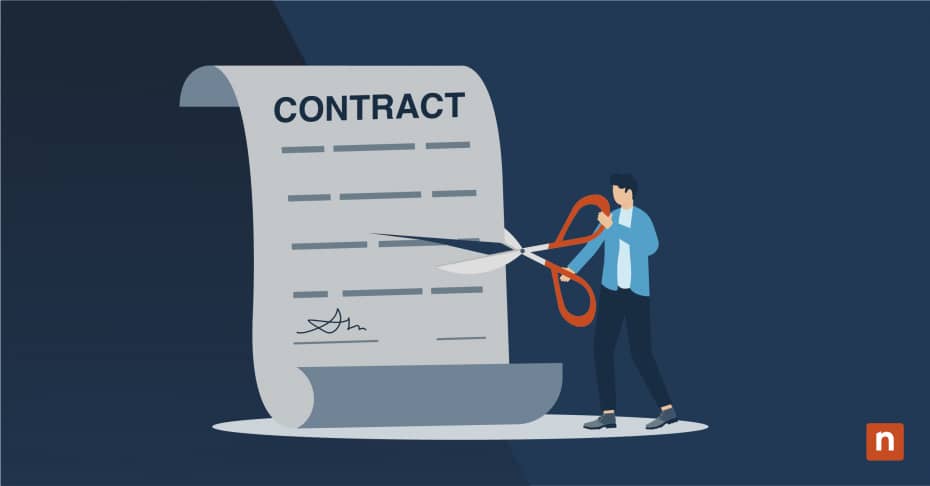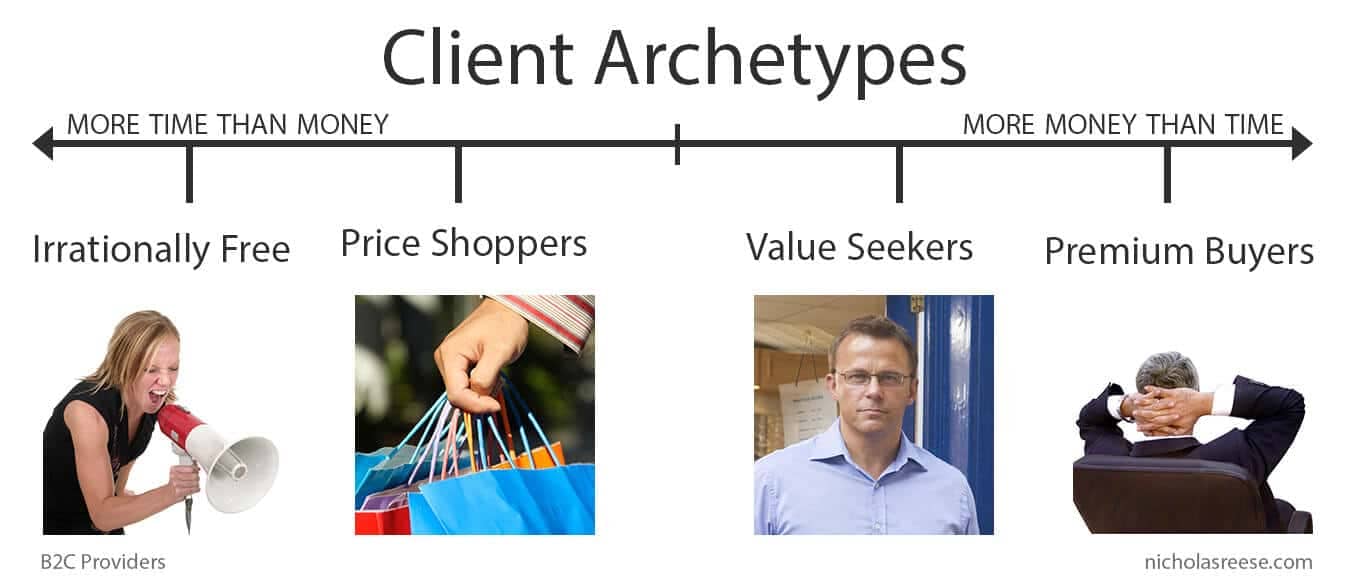Is your business being pulled down by one or more bad clients? This guide will walk you through how to let go of clients who aren’t a good, profitable fit, so you can focus on clients and prospects who are.
We all know breaking up is hard to do.
Considering the global uncertainty that hasn’t taken a day off since the pandemic got rolling, it’s perhaps harder than ever to walk away from a client — even a bad one.
If your first reaction to the thought of kissing goodbye perfectly good MRR is “Heck no — not in this economy!” you’re not alone. But when you know a client is causing you and your team stress or, even worse, stealing your sanity and your profitability, well, you truly are better off saying goodbye.
That doesn’t mean you have to go it alone, though. We’re here to help talk you through it by guiding you through the following and more:
- Reasons you should and shouldn’t consider firing a client
- Signs it’s time to say goodbye to a client
- Tactics for firing a client successfully
- How to avoid bringing on the wrong clients in the first place
- And more
So whether you’re in the midst of trying to figure out how to handle a less-than-ideal situation, or just looking for preventative tips to keep out of one, read on to learn truly everything there is to know about breaking up with MSP clients.
How to tell when it’s time to fire a bad MSP client (or not)
Aside from a few other not-so-nice adjectives, bad clients are, simply put, a drain.
- They drain the precious time you could be spending building your business.
- They drain your staff and other business resources without adding commensurate value.
- They can even drain your bank account if you don’t recognize and cut them off quickly enough.
Let’s explore the leading reasons you should consider, and a few reasons you should reconsider, firing a client despite today’s uncertain economy.
3 key reasons to consider firing a client
There are as many reasons to cut ties with an MSP client as there are MSP businesses — it’s truly a case-by-case decision. However, these are what we think are some of the more universal reasons to consider ending a client relationship.
1) Not all revenue is created equal

We were inspired by this social media conversation about firing bad MSP clients to think about the Pareto principle, which is named for Italian economist Vilfredo Pareto who noted the phenomena that, often, 80% of consequences are the result of 20% of the causes.
The way this applies to your MSP business is that, in many cases, 20% of your clients will generate 80% of your revenue. And similarly — 20% of your clients might be responsible for 80% of your stress!
For clients who don’t fall into the first 20% but do fall into the second 20%, it might be time to consider letting them go so you can focus on building a brand (learn more about that from our chat with branding expert Matthew Fox at Valiant Technology) and upping your level of service so you can move your business in a more profitable direction.
2) Bad clients are a dangerous liability
Clients who consistently open themselves up to risks aren’t just a liability to themselves — they put you, the MSP that has made itself (partially) responsible for protecting their business’s data and functionality, at risk.
If a client refuses to upgrade their old devices, keeps downloading untrustworthy software you’ve advised against, won’t keep the security adjustments you’ve made up to date, and generally doesn’t take their business safety or your expertise seriously; they’re on a bad path and they’re taking you down it with them. It’s time to seriously consider parting ways.
3) The wrong clients can keep you from making the right business decisions
Sometimes a client isn’t so much “bad” as they are “wrong.”
MSPs often outgrow their original client base as they settle into their niche, grow their staff, and need to start charging higher prices. Neither party did anything wrong in this scenario, but if you choose not to create new arrangements or ultimately cut ties with clients that are keeping you from making the moves you need to make to grow, you might be the one responsible for creating a client relationship that’s gone bad.
Tom Watson, Channel Chief Advisor at NinjaOne and former MSP business owner, ended up getting rid of more than 10% of his own clients eight years into running his MSP in order to grow. “You get to later in that maturity of an MSP and you start taking on larger clients, co-managed IT deals, and you start looking at it going, ‘Wow, I’ve got three clients that I’m making 50% of my revenue from and then I’ve got these ten other clients that don’t even equal that! I’m geared more towards larger clients now. I need to have a talk with these guys.’”
Don’t forget, you can watch the whole chat here.
When you should rethink firing a client
If your client doesn’t ring any of the above alarm bells but you’re still on the fence, here are another set of elements to reconsider to help determine if you should give it another shot.
1) You literally can’t afford to lose them
Maybe you’re still a single-person shop. Maybe you’re actively building out your client pipeline. Or maybe, like plenty of other businesses, the past year has just been rough on your business.
Sometimes, the truth is that you simply can’t afford to fire a single paying client.
That’s okay. If you’re in that spot, stick it out — just don’t become complacent and fall into the trap of letting the wrong clients determine your business direction like we mentioned above.
2) The client is more challenging than bad
Sometimes when we’re experiencing burnout, which plenty of us have during the past year, it can be hard to tell if a client is actually unfavorable or if it’s just our outlook that’s grim at the moment.
Of course, what “bad” means is different to everyone, but we’ve put together a few comparisons to help you determine when a client is actually a poor fit for your business and when they’re just, ahem, difficult.
- Challenging clients can ask a ton of questions because they don’t understand your services, but bad clients automatically think they know all the answers — and will fight your decisions every step of the way.
- Challenging clients might be a little hard to get ahold of from time to time, but bad clients will communicate irrationally — sending 15 emails one day then neglecting to reply to you in any way for the next two weeks.
- Challenging clients might balk at your pricing and recommendations because they’ve never worked with an MSP before, but bad clients think they should have the power to align your budget, your business decisions, and even your timeline with what they think it should be.
Dealbreakers: 5 signs it’s time to say goodbye to a client asap
Some client behaviors warrant a “Hmm, maybe I should reconsider this agreement” feeling while others give off an “I should definitely run away screaming” vibe.
If you have an MSP client who displays any of the following habits, we recommend you do indeed run away screaming — in a professional(ish) way, of course.
1) Abusive or unprofessional treatment
Yelling at your staff over the phone. Using demeaning language in emails. Sending a flurry of irate texts about a non-emergency at 9 p.m. on a Saturday — or any time, for that matter. This and any other behavior that alarms and scares your team or oversteps professional boundaries is abusive and grounds for immediate firing.
2) Lack of respect for your expertise
The above abusive treatment often results from clients who don’t respect the expertise of your MSP business.
Even when a client isn’t using obviously abusive language, they can show their disdain in other ways. Often with bad MSP clients, this shows itself through an unwillingness to comply with your expert recommendations for protecting and improving their business. This happens because the client thinks they know more about networks and security than you possibly can (*insert eye roll*). As such, they’ll eventually start undermining your and your staff’s capabilities and, of course, prices.
Run while you still have time.
3) Repeated security scares
One of the scarier things that can come from clients ignoring and even going against your expertise is risks pertaining to their business security and compliance. If a client is willing to put their business at risk just to prove how much more they trust their own opinion than yours — let them. Just make sure you’re no longer under contract with them when they do.
Considering today’s increasingly sue-happy business environment, don’t put your own MSP business and future insurability in jeopardy just because a bad client is willing to do the same with theirs.
4) Unreasonable demands or expectations
Just asking questions or making an odd request here and there isn’t usually a fireable offense. It’s much better to have an inexperienced yet curious client than it is to have a demanding one who doesn’t seem to learn when you try to teach them which requests and expectations are simply unreasonable.
A client who’s convinced they know it all and isn’t willing to bend to reason isn’t one you want to keep letting grind down your morale.
5) Recurring late payments
“The red flags to me are do they pay their bills on time?
Ideally prepaid, before the month starts if you’re under managed services. If you’re sending them a break/fix invoice, are they paying that within the amount of time, like, net 30 or whatever you have for terms? Do you have to contact them repeatedly?

— Tom Watson, Channel Chief Advisor at NinjaOne
In the wise words of our Channel Chief Advisor, money now is worth more than money later!
Tom had a core business rule that helped him build an MSP business that was so successful he was able to eventually sell and exit: Make sure every client signs a payment agreement and make sure that agreement arranges for upfront payment for services.
If a client is uncomfortable agreeing to these terms or makes a late payment even once, say goodbye to them permanently before you have to say goodbye permanently to the money they owe you.
How to cut ties with MSP clients
If you’ve determined you’ve got a bad MSP client on your hands and you’re ready to break off the relationship, we have just one more solution for you to consider — as well as some tips on how to cut ties professionally if you decide to do so.
Raise your rates or make a clean break?
If your client doesn’t portray any of the immediate dealbreaker behaviors and you’re on the fence about ending the relationship, here’s something to think about: Ask them for more money. Or, as others have put it, institute a pain-in-the-ass (PITA) tax.
Sometimes, a problem client is easily transformed into a manageable one when you have enough funds to support their (somewhat incessant) needs.
That said, several people who chimed in on our live chat did warn to exercise this approach with caution — you don’t want to further sour (and then get stuck in) an already rocky relationship or give an embittered ex-client ammunition for bad reviews.
How to end a client relationship on good terms
So, you’ve considered it all and you’re still ready to move forward with the breakup. These things happen. But here are some high-level tactics to help you end your working relationship on as good of terms as are possible in the situation:
- Check your legal agreement: Keep everything above board by making sure your breakup is in line with the contract your client signed.
- Keep it professional: Provide precise and professional reasons for ending the client relationship.
- Be ready to help with the transition: The logistics of transferring to a new MSP can be confusing for clients, so be prepared for questions from both them and their eventual new provider.
- Provide references: If they weren’t a nightmare to work with, it can’t hurt to engender a little goodwill all around by putting your soon-to-be ex-client in touch with other MSPs who might be able to serve them better.
Not sure how to deliver the breakup news? This is kind of complicated now that social distancing is the norm, but it’s ideal to have a phone call at the least and a safe, in-person meeting when possible. Of course, you should decide what’s best considering the length and depth of the relationship.
On the live chat, MSP owner Alex recounted all the times he didn’t handle a client breakup so well and advised that MSPs handle those tough conversations in person (only when reasonable and always safely, of course): “I would absolutely do it face to face. And I, more than once, went to someone’s office with a check for what they had prepaid me in managed services and handed them their check back and said, ‘Here’s the money that we owe you. You are no longer our client. See you later.’ And it’s worth it.”
Not sure exactly what to say? There are some great scripts to help you get started here.
Lessons learned: Two ways to avoid bad relationships from the start
Breaking up with a bad MSP client sure is a process. To avoid exhaustion in the future, here are some tactics you can try out to prevent ever hiring, and eventually having to fire, clients that were never a good fit for your business.
1) Say “no” to clients that don’t fit your ideal client archetype
Once your MSP business is established, you’ll get to finally start doing this awesome thing called “saying no.”
Unfortunately, plenty of MSPs — and business owners of all types — never actually get good at this because they’re scared they may make the wrong call and turn away a dream client.
However, once you get familiar with the client archetypes that serial entrepreneur Nick Reese developed here, you’ll be better equipped to understand which clients to pursue and which you can safely say no to.
2) Set clear expectations
A great way to avoid an eventually strained relationship is to be exceedingly clear about what you will provide and what your client can expect.
The best place to set clear expectations? Get started by downloading our free managed service agreement template.
In addition, standardizing what you can across your business will make it easier to ensure that each client has similar expectations and that you’re delivering on all of them with a high level of service.
Here’s what our Channel Chief Advisor Tom said about how standardizing services enabled him to set clear, cross-client expectations: “ … I came up with the idea that I was gonna offer a suite of services, my own stack, that everyone under contract had to have the same stack, that they needed to understand the proactive approach to IT. …. And if clients didn’t wanna buy into that and they didn’t wanna understand a proactive approach to IT where I wasn’t responding to everything, but rather we were doing things to make it so that we could respond to problems or that we knew about them before the client contacted us, then I had to let them go.”
How to keep your client list healthy with ongoing management and pruning
Eliminated the truly bad clients and implemented a few rules to help prevent bringing on more in the future? Then you’re in a healthy place. The final step to making sure you stay in that place is putting the following systems in place so none of your clients ever get on the path to going bad.
Develop an evaluation system
We’re taking you back to school — it’s time to start grading clients.
Develop a system for evaluating clients on how they perform on key metrics that are important to you. By tracking their grades on these metrics over time, you’ll be able to tell if a client’s behavior is changing for the worse and hopefully correct it before it comes to a breakup.
Here are some evaluation metrics to consider:
- New tickets opened
- Reopened tickets
- Admin requests
- Management escalations
- Disputed invoices
- Average days to pay invoices
- Profitability
- Recommendations implemented/ignored
To see how one MSP leader used their evaluation system to drop bad clients that made up 25% of their revenue — and are happy they did — read Ivan’s story here.
And you can grade your own clients just like they did with this custom scorecard from NinjaOne.
Ask your staff what they think
In addition to an evaluation system, do a regular gut check with your staff to see what they think about your clients — after all, they’re probably in contact with your clients more regularly than you are.
One social media commenter who says he’s been in the MSP biz for over three decades says he asks his staff to name who they think are their five “worst clients” every year. This gives him a jumping-off point from which to evaluate and sometimes even fire clients who are introducing toxicity to the team.
Looking for more client advice? Don’t miss our upcoming MSP Live Chats.
We hope this guide helped you learn how to spot and tactfully let go of egregious MSP clients as well as how to put systems in place to keep you from ever signing on with a bad apple again.
We have to thank the awesome guests from our February 2021 MSP Live Chat: Breaking Up with Bad Clients for much of the advice we’ve shared today.
Be sure not to miss our next live chat, where you can learn valuable advice and make lasting connections with other MSPs just like yourself.
Click here to save your spot for our next live chat and visit our back catalog of videos and other resources from chats covering everything from building your 2021 MSP tech stack to demystifying cyber insurance and beyond.








